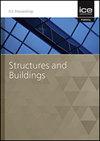Analytical and Numerical Study of Fire-Damaged Circular Concrete Columns Repaired Using Composite Confinement Techniques
IF 1.4
4区 工程技术
Q3 CONSTRUCTION & BUILDING TECHNOLOGY
Proceedings of the Institution of Civil Engineers-Structures and Buildings
Pub Date : 2022-05-24
DOI:10.1680/jstbu.21.00017
引用次数: 0
Abstract
This paper presents numerical and regression modeling of 21 undamaged, fire-damaged, and repaired fire-damaged reinforced circular concrete (RC) columns. The columns were exposed to three different temperatures of 300°C, 500°C, and 900°C and tested for axial residual capacity. It was found that concrete loses its strength after exposure to a temperature of 300°C or above. Fire-damaged columns were then repaired using various composite confinement techniques. Strength was regained when CFRP confinement was applied to fire-damaged columns but it increased the deformation as well and thus reduced the stiffness which is not desirable. To overcome this challenge, steel wire mesh, filled with cement sand mortar and wrapped with CFRP was employed. Further, a numerical model was developed that could precisely predict the residual capacity of these columns. The paper briefly reviewed and summarised the development of numerical techniques, including material properties, geometry, elements, loading, boundary conditions, and contact algorithm for undamaged, fire-damaged, and repaired fire-damaged columns. Moreover, analytical equations were developed using linear, multiple, and quadratic regression modeling. The results obtained using the proposed model and regression equations showed that these models offered a better alternative to the experimental testing for the prediction of the post-fire performance of damaged and repaired RC columns.火灾损伤圆形混凝土柱复合约束修复的分析与数值研究
本文对21根未损坏、火灾损坏和修复的钢筋圆形混凝土柱进行了数值和回归建模。柱暴露在300°C, 500°C和900°C三种不同的温度下,并测试轴向剩余容量。研究发现,混凝土暴露在300°C或以上的温度下会失去强度。然后使用各种复合约束技术对火灾损坏的柱进行修复。当CFRP约束应用于火灾破坏柱时,强度得到恢复,但也增加了变形,从而降低了刚度,这是不理想的。为了克服这一挑战,采用了水泥砂砂浆填充、碳纤维布包裹的钢丝网。此外,还建立了一个数值模型,可以精确地预测这些柱的剩余容量。本文简要回顾和总结了数值技术的发展,包括材料特性、几何形状、元素、载荷、边界条件和接触算法,用于未损坏、火灾损坏和修复的火灾损坏柱。此外,利用线性、多元和二次回归模型建立了解析方程。利用该模型和回归方程得到的结果表明,该模型可以较好地替代试验测试来预测受损和修复的RC柱的火灾后性能。
本文章由计算机程序翻译,如有差异,请以英文原文为准。
求助全文
约1分钟内获得全文
求助全文
来源期刊
CiteScore
3.40
自引率
6.20%
发文量
61
审稿时长
12 months
期刊介绍:
Structures and Buildings publishes peer-reviewed papers on the design and construction of civil engineering structures and the applied research associated with such activities. Topics include the design, strength, durability and behaviour of structural components and systems.
Topics covered: energy conservation, people movement within and around buildings, strength and durability of steel and concrete structural components, and the behaviour of building and bridge components and systems

 求助内容:
求助内容: 应助结果提醒方式:
应助结果提醒方式:


